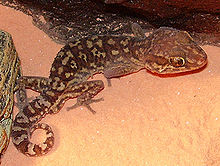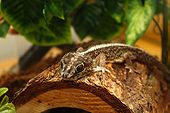- Ocelot Gecko
-
Pictus Gecko 
Scientific classification Kingdom: Animalia Phylum: Chordata Class: Reptilia Order: Squamata Family: Gekkonidae Genus: Paroedura Species: P. pictus Binomial name Paroedura pictus
Peters, 1854The Pictus Gecko (Paroedura pictus) is a nocturnal ground dwelling gecko found in the leaf litter in forests on the island of Madagascar. It is sometimes seen in the herpetology world as the Madagascar Ground Gecko, Ocelot gecko, Malagasy fat tailed gecko, or Panther Gecko.
Contents
Characteristics
P. pictus naturally occurs as a brown lizard with black markings. Some individuals may also have a white dorsal stripe. In captivity, there are several color phases available including orange and amelanistic (yellow).
They usually reach a size ranging from 4 to 6 inches, with some well cared for males pushing 8 inches. Overall they are a relatively small gecko.
The ocelot gecko is not a true climbing gecko, but does have some capability to climb some surfaces. In captivity, this small gecko has been known to scale the sides of glass terrariums if startled. Most of them don't have a tendency to bite and are very tame. At a young age, they are very jumpy, and handling should be kept to a minimum. When they get older MOST become more docile and relax if held. If this gecko is bought from a pet store, it has probably been taken from the wild, unless it is labeled as CBB (Captive Bred and Born). These geckos come from Madagascar, and are known among gecko-lovers for having very interesting personalities.
In Captivity
These geckos have been found to do well in captivity and are fairly easy to care for. Because of this they have been becoming increasingly popular in the Herpetology Community. A recommended first species for anyone looking into the hobby. They have similar care to a leopard gecko, and in captivity have really shown nice patterns. There are a few morphs of this species including xanthic, snow, anery, striped, triple striped and red. This is due to selective breeding. Usually geckos with these markings are more expensive and range from a price of $20 -$45.
Housing
A single gecko can be kept in a 10 gallon terrarium with substrates such as Repti-Carpet, and Paper towels. For multiple geckos you can use a 20 gallon tank (this could house up to two geckos, but that is only a minimum, please get the largest size possible). But care must be taken when placing multiple geckos in the same tank, Never place two males together in the tank for they will become territorial and may kill each other. Also if you have one male and multiple females be prepared for eggs because these geckos are prolific breeders, so the safest bet for multiple geckos is having them be all female. But there might be a dominant female, which can bully the others and result in death, these animals should be separated, unless for breeding purposes. They must also be provided with at least three hides. One on the warm end (86 °F) one in the middle and one on the cool end (herpes:p80-82 °F) of the tank. You may also want to provide them with a moist hide to aid in shedding, which is usually the hide on the warm end. This can consist of some sort of container with an opening for the gecko to enter and exit and inside should be something that will retain moist air and raise the humidity in the chamber such as paper towels or Peat Moss (these must be misted regularly to maintain the humidity.)
Feeding
This gecko is a true insectivore and will readily accept small live prey such as crickets and mealworms. Hatchling Pictus Geckos should be fed appropriately sized crickets dusted with a reptile vitamin supplement on a daily basis (feed as many as the gecko will eat in a 20 minute period). Once they become juveniles, feeding should be reduced to 5 to 6 times a week with appropriately sized crickets and they should be dusted with vitamins only once or twice a week. The feedings that the crickets are not dusted with vitamins they should be dusted with a pure calcium powder. Also mealworms can be place in a dish in the tank at all times; these geckos will not overeat if they are not hungry. A good rule of thumb for cricket sizes is that the cricket should be no longer than the distance between the eyes of the gecko. Usually they eat 2-3 crickets, but if you don't like the crickets, you can buy silkworms. Silkworms are usually not sold in petstores but there are many online breeders.
Breeding
The Ocelot gecko is fast to mature, taking less than a year in captivity. At about six months male will be easily distinguishable due to the large bumps they will get at the base of the tail, and a female will just be smooth at the base of the tail. They are also very easy to breed in captivity. The difficult part is controlling their breeding, these are very prolific geckos. After two of these Geckos have mated and the female is gravid in about 2-3 weeks the female will lay her eggs (usually in the moist hide). The male should be separated from the female after mating to reduce Stress on the female. The female will lay two eggs per clutch every two or so weeks. They will also retain sperm so be prepared for multiple clutches usually around five clutches per mating. The eggs should be incubated at around 80 °F (27 °C) and should take between 30-60 days to hatch, though there have been cases where it has taken up to 120 days for an egg to hatch. once the eggs have hatched the [hatchlings] should be place in a cage with the set up requirements listed above except paper towel substrate should be used to avoid impaction and they may be kept in a smaller tank size. Once they have their first shed they should be fed as described above. As they grow and get bigger they should be moved up to the appropriately sized tank and can be on Repti-Carpet or paper towels. Please note though, don't try to breed these geckos until at least 2 years of experience and you need to do a lot of research.
Categories:
Wikimedia Foundation. 2010.

